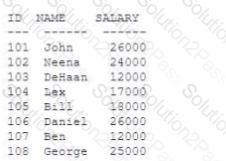1z0-071 Oracle Database 12c SQL Free Practice Exam Questions (2025 Updated)
Prepare effectively for your Oracle 1z0-071 Oracle Database 12c SQL certification with our extensive collection of free, high-quality practice questions. Each question is designed to mirror the actual exam format and objectives, complete with comprehensive answers and detailed explanations. Our materials are regularly updated for 2025, ensuring you have the most current resources to build confidence and succeed on your first attempt.
Which two are true about external tables that use the ORACLE _DATAPUMP access driver?
Examine the data in the CUST NAME column of the CUSTOMERS table:
CUST_NAME
------------------------------
Renske Ladwig
Jason Mallin
Samuel McCain
Allan MCEwen
Irene Mikkilineni
Julia Nayer
You want to display the CUST_NAME values where the last name starts with Mc or MC. Which two WHERE clauses give the required result?
You execute this command:
TRUNCATE TABLE depts;
Which two are true?
View the Exhibit and examine the structure of the ORDERS table.
The columns ORDER_MODE and ORDER TOTAL have the default values'direct “and respectively.
Which two INSERT statements are valid? (Choose two.)
Examine the data in the CUST_NAME column of the CUSTOMERS table:
CUST_NAME
---------------------
Renske Ladwig
Jason Mallin
Samuel McCain
Allan MCEwen
Irene Mikkilineni
Julia Nayer
You want to display the CUST_NAME values where the last name starts with Mc or MC.
Which two WHERE clauses give the required result?
Which two statements are true about truncate and delete?
Which two statements are true about the order by clause when used with a sql statement containing a set operator such as union?
Examine the description of the CUSTOMERS table:
Which three statements will do an implicit conversion?
Which two are true about constraints?
Examine the description or the BOOKS_TRANSACTIONS table:

FOR customers whose income level has a value, you want to display the first name and due amount as 5% of their credit limit. Customers whose due amount is null should not be displayed.
Which query should be used?
Examine the description of the BOOKS table:

The table has 100 rows.
Examine this sequence of statements issued in a new session;
INSERT INTO BOOKS VALUES (‘ADV112’ , ‘Adventures of Tom Sawyer’, NULL, NULL);
SAVEPOINT a;
DELETE from books;
ROLLBACK TO SAVEPOINT a;
ROLLBACK;
Which two statements are true?
Which two are true about granting privilege on objects?
Examine the contents of the EMP table:

Examine this query that executes successfully:

What is the result?
Which three statements are true about inner and outer joins?
Examine the description of the CUSTONERS table

CUSTON is the PRIMARY KEY.
You must derermine if any customers’derails have entered more than once using a different
costno,by listing duplicate name
Which two methode can you use to get the requlred resuit?
Examine the description of the PRODUCTS table:

Which two statements execute without errors?
Which statement will return a comma-separated list of employee names in alphabetical order for each department in the EMP table?
What is true about non-equijoin statement performance?
Which two are true about the USING clause when joining tables?
Which three statements are true about the Oracle join and ANSI Join syntax?
